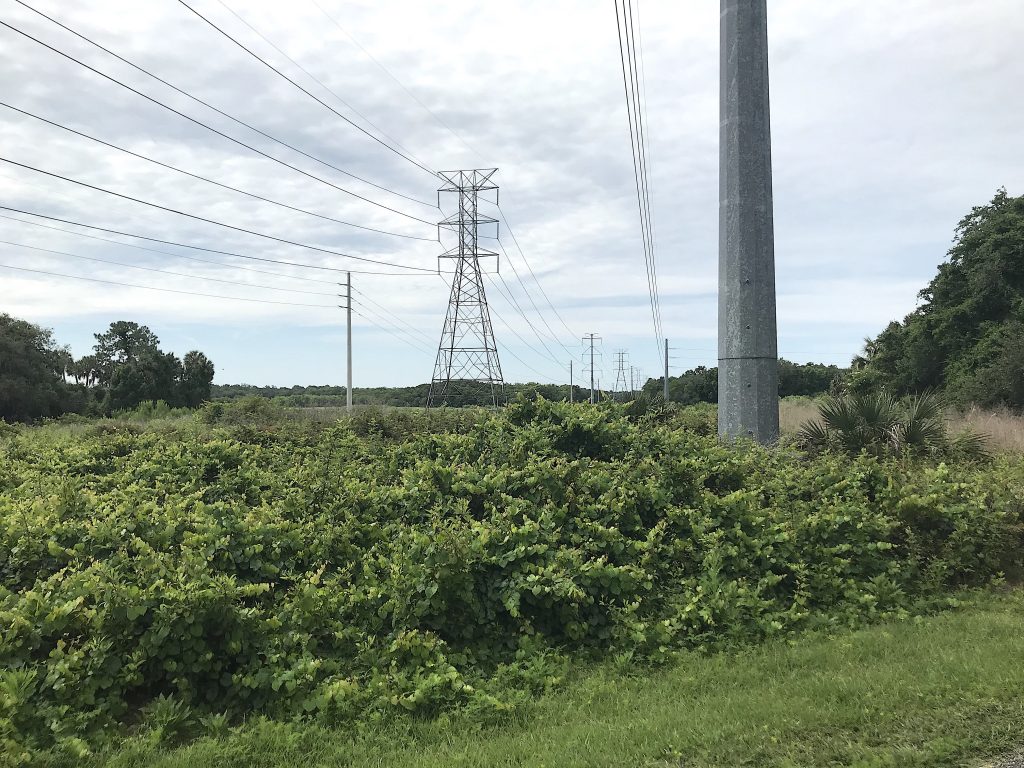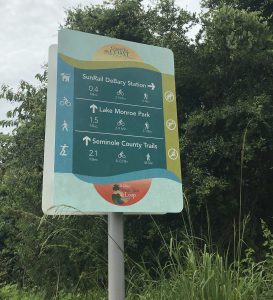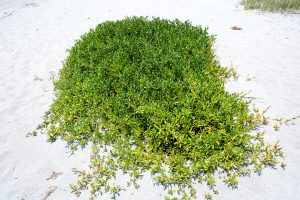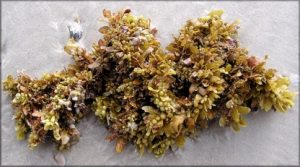
Blackberries along the bike trail. Photo by Green Deane

Train or trail, you can get there either way.
Acres of wild blackberries… well, perhaps not acres but certainly a lot of them. Where? On the bike trail between Lake Monroe Park and Gemini Springs Park in south Volusia County. That part of the bike trail wends its way for a little over a mile between two parking lots. Look for the powerlines… this same area will also have in a couple of months bushels of Passiflora incarnata, Maypops… along the way to this location on the southern side are many cattails and to the west of Gemini Springs Park (in the cow pasture) there are a lot of Pawpaws. The things ones see while riding a bike. And… if you like to travel by train there is a Sunrail stop (Debary) directly west of the patch (and a path to said on the east side of U.S. 17-92.) As they are wild blackberries they are well armed. And a reminder that foraging is illegal in Florida so proceed stealthily. Why is foraging illegal? Unanswerable officials have to have something to do. If we had a Commissioner of Ants there would be all kinds of ant rules, do’s and don’t’s and fines et etcetera. The more government the more rules and the more functionaries to interfere with your life. In theory elected official were supposed to make all the rules and be accountable for all of them. If we didn’t like the rules or decisions we vote them out of office. But then politicians made unanswerable committees, commissions and departments to make and enforce rules. These add-on bureaus do not answer to the people or to the elected officials that created them. If a wildlife commission makes a truly stupid decision and citizens don’t like it, tough. Thus the second rule of foraging is “no witnesses.” The third rule is “eat the evidence.” The first rule of foraging is wash your hands BEFORE you go to the bathroom ’cause you never know what you’ve been touching…

Seeding Seablite. Photo by Green Deane
Saw large amounts of Seablite this past weekend. Depending where you are in the state it is either starting its seasonal run or close finishing it. An excellent contender for a commercial crop it’s in the Chenopodium family. There was copious amounts of it at Fed Howard Park west of Tarpon Springs. We also saw Sea rocket and Silverhead but the prime edible was Seablite. Curiously on the mainland side of the park some of the Seablite was bitter. It is usually a very mild green edible raw or cooked. You can read about Seablite here or see my video here.
Foraging classes: On the east coast of Florida this weekend. Should have good weather.
Saturday, May 22th, George LeStrange Preserve, 4911 Ralls Road, Fort Pierce, FL, 34981. 9 a.m. to noon, meet at the parking lot.
Sunday, May 23th, Wickham Park: 2500 Parkway Drive, Melbourne, FL 32935-2335. Meet at the “dog park” inside the park, 9 a.m. to noon.
Saturday, May 29th, Boulware Springs Park, 3420 SE 15th St., Gainesville, FL 32641. Meet at the picnic tables next to the pump house. 9 a.m. to noon.
Sunday, May 30th, Tide Views Preserve, 1 Begonia Street, Atlantic Beach Fl 32233 (near Jacksonville Fl.) 9 to noon. Meet at the parking lot.
For more information, to prepay or sign up for a class go here.
Sea Purslane and Purslane are not the same species, they are not related, and they prefer different environments. But, there is a general resemblance between the two; it just depends on how closely you look. Both are edible, look like succulents, grow in a similar pattern, and are close in coloring. But one prefers rich garden soil and the other tolerates salty areas. That said Sea Purslane will grow in your garden it just competes well in briny locations. It is one of those odds oversights that Sea Purslane is not protected like Sea Oats. Like edible Sea Oaks Sea Purslane helps build and maintain beach dunes.

Sea Purslane building its own mound and mini-environment. Photo by Green Deane
On the brackish inland water way you will find Sea Purslane almost anyplace near the water, mixed in with other salt-tolerant vegetation. But on the sea side it is one of the few edibles you will find directly on the beach, year round. Sea Purslane’s niche is that its fleshy leaves causes the sand-carrying wind to slow down. That make the wind drop the sand it was carrying. This makes little dunes and in time little dunes grow into big dunes. The Sea Purslane also keep growing to cover its own dune which helps to keep in moisture and reduce the sand temperature in the summer. In many areas of Asia Sea Purslane is a commercial vegetable. It’s also very easy to propagate. Just stick a stem in moist soil. To read more about Sea Purslane go here.

Sargassum: Edible but not the best of tastes.
It is said that if a botany professor does not like a particular graduate student an impossible assignment is given: List all of the Hawthorne species. There is no agreement if there are dozens of Hawthorne species or thousands. Blueberries are not quite as bad but it’s another family that can be difficult to sort out: Are there dozens or hundreds? Grapes can be tough, too. My candidate for confusion is seaweed. Even with good descriptions each species can vary a lot making identification difficult. This seaweed was seen on Venice Beach. My first problem is deciding if it is a brown seaweed or a red seaweed. I went with brown but that could be wrong. It seems reasonable to call it a Sargassum and yet there are two forms and many species. Some create a floating mat, the so called free-form. Others attach to something. This was clinging to a bit of seashell. At first I thought “Attached Sargassium” aka Sargassium hystrix. But that bothers me because “hystrix” means “bristly” or “spiny.” I could not see or feel anything on this seaweed that could be called “bristly” or “spiny” yet it looks otherwise about right. The leaves are not toothy, the bladders do not have long stems or a hook on the end like other Sargassums. And it does have irregular dark spots on the leaves. To complicate the matter most S. hystrix have white veins and others do not such as S. hystrix var. buxifolium. I’m definitely in over my seaweed head. To read more about Sargassums go here.

Green Deane videos are now available on a USB.
150-video USB would be a good spring present and is now $99. My nine-DVD set of 135 videos has been phased out. The USB videos are the same videos I have on You Tube. Some people like to have their own copy. The USB videos have to be copied to your computer to play. If you want to order the USB go to the DVD/USB order button on the top right of this page. That will take you to an order form. I’d like to thank all of you who ordered the DVD set over the years which required me to burn over 5,000 DVDs individually.

Green Deane Forum
Want to identify a plant? Perhaps you’re looking for a foraging reference? You might have a UFO, an Unidentified Flowering Object, you want identified. On the Green Deane Forum we — including Green Deane and others from around the world — chat about foraging all year. And it’s not just about warm-weather plants or just North American flora. Many nations share common weeds so there’s a lot to talk. There’s also more than weeds. The reference section has information for foraging around the world. There are also articles on food preservation, and forgotten skills from making bows to fermenting food.
 Your donations to upgrade the EatTheWeeds website and fund a book were appreciated. A book manuscript has been turned it. It had 424 articles, 1325 plants and a third of a million words. What it will be when the publisher is done with it next year is unknown. It will be published in the spring of 2023. Writing it took a significant chunk of time out of my life from which I have still not recovered. (Many things got put off.) The next phase is to update all the content on the website between now and publication date. Also note as it states above the 135-video DVD set has been phased out for 150-video USB. Times and formats change. Which reminds me I need to revisit many plants and make some new videos.
Your donations to upgrade the EatTheWeeds website and fund a book were appreciated. A book manuscript has been turned it. It had 424 articles, 1325 plants and a third of a million words. What it will be when the publisher is done with it next year is unknown. It will be published in the spring of 2023. Writing it took a significant chunk of time out of my life from which I have still not recovered. (Many things got put off.) The next phase is to update all the content on the website between now and publication date. Also note as it states above the 135-video DVD set has been phased out for 150-video USB. Times and formats change. Which reminds me I need to revisit many plants and make some new videos.
This is weekly newsletter #457. If you want to subscribe to this free newsletter you can find the sign-up form in the menu at the top of the page.
To donate to the Green Deane Newsletter click here.


Thank you SO SO much for making your videos available on USB drive! If anyone hasn’t purchased this YOU ARE MISSING OUT! I binge watch Deane instead of Netflix! Great info! 😀
Thanks for the feedback. I will be adding more new videos.
Foraging competes with the
commercial markets which probably means some commissioners are in at least one special interest pocket AND Florida grows a lot of fruits and vegetables. This
means rules and regulations that protect these special interests. It’s the American way isn’t it?!